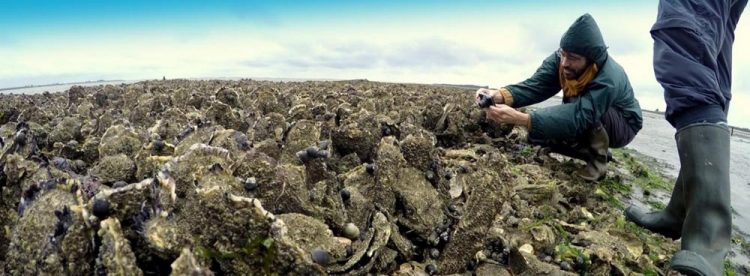Sea shells for sale: A new source of sustainable biomaterials

Artificial oyster reef in the Netherlands is pictured. Credit: Dr James Morris
“Mollusc shells are viewed by the aquaculture and seafood industries as 'nuisance waste' and largely disposed of in landfills”, says Dr Morris. “Not only is this an expensive and ecologically harmful practice, it is a colossal waste of potentially useful biomaterials”.
One of the most exciting applications proposed by Dr Morris is the use of discarded shells to restore damaged oyster reefs and cultivate the growth of new oysters. The restoration of these reefs requires little money and effort, but can have huge ecological advantages.
“Healthy shellfish populations can have many benefits to the environment: cleaning the water, providing a complex structure for other organisms to call home, and also acting as a coastal protection structure,” explains Dr Morris.
Mollusc shells consist of over 95% calcium carbonate, which is used in many agricultural and engineering applications. Crushed shells can be spread on farmer's fields to control soil acidity or fed to egg-laying hens as a calcium supplement.
Calcium carbonate is also a common ingredient in cement mix and has found additional use in effectively treating wastewater. Unfortunately, the vast majority of the world's calcium carbonate comes from ecologically harmful and unsustainable limestone mining.
“Reusing shell waste is a perfect example of a circular economy, particularly as shells are a valuable biomaterial, not only does it improve the sustainability of the aquaculture industry moving forwards, but it can also provide secondary economic benefits to shellfish growers and processors as well,” says Dr Morris.
By researching how mollusc shells can act as a secondary source of calcium carbonate, Dr Morris and his team hope to provide a more sustainable alternative to mined limestone. He hopes that his work will emphasise the economic value of recycling these discarded shells back into use.
“The proper disposal procedure for shell waste is in landfill, which costs a lot of money and can be a big burden for shellfish farmers and seafood producers,” says Dr Morris, “simply finding a use for shells to avoid taking them to a landfill already has economic value!”
Media Contact
All latest news from the category: Life Sciences and Chemistry
Articles and reports from the Life Sciences and chemistry area deal with applied and basic research into modern biology, chemistry and human medicine.
Valuable information can be found on a range of life sciences fields including bacteriology, biochemistry, bionics, bioinformatics, biophysics, biotechnology, genetics, geobotany, human biology, marine biology, microbiology, molecular biology, cellular biology, zoology, bioinorganic chemistry, microchemistry and environmental chemistry.
Newest articles

A universal framework for spatial biology
SpatialData is a freely accessible tool to unify and integrate data from different omics technologies accounting for spatial information, which can provide holistic insights into health and disease. Biological processes…

How complex biological processes arise
A $20 million grant from the U.S. National Science Foundation (NSF) will support the establishment and operation of the National Synthesis Center for Emergence in the Molecular and Cellular Sciences (NCEMS) at…

Airborne single-photon lidar system achieves high-resolution 3D imaging
Compact, low-power system opens doors for photon-efficient drone and satellite-based environmental monitoring and mapping. Researchers have developed a compact and lightweight single-photon airborne lidar system that can acquire high-resolution 3D…





















